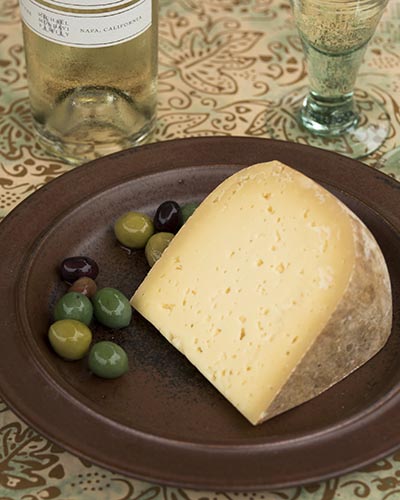For years, I’ve thought of Monterey Jack as the White Zinfandel of cheese. It’s easy to like, reasonably priced, available everywhere and—I would hope—a bridge for cheese consumers to more interesting choices eventually.
Now, thanks to the Schoch family, I know that Monterey Jack can be worthy of a connoisseur’s cheese board if given the artisan treatment. The Schoch patriarchs, Adolph and Ernest, were brothers and Swiss immigrants who settled in California’s Salinas Valley in the 1940s. They established a dairy farm that, today, is one of the few remaining in Monterey County. And now Ernest’s grandsons—three brothers—have built a creamery and developed a Monterey Jack, ironically the only one produced in the county. Dad does the milking, while the boys make and market the cheese.
Schoch Family Monterey Jack is unusual and admirable on several levels. Number one: It has a rind. Monterey Jack today is mostly a bland commodity cheese, made in rindless blocks, in volume, intended for deli sales and sold more on price than on quality. The Schoch jack is made by hand, three dozen 10-pound wheels at a time, and it develops the rind over eight to nine months of aging and repeated washing with brine and beer.
What’s more, it’s a raw-milk farmstead cheese, meaning that the family uses only the milk from their own small herd of Holsteins. Perhaps most important for cheese quality, the milk is never chilled. It goes straight from the milking parlor to the cheese vat. Cheesemaker Beau Schoch uses animal rennet, another traditional and increasingly rare practice, which contributes some bite to the finish. Another departure from the norm: the aging room has no artificial refrigeration or humidifier. Instead, the creamery relies on the moist night air from nearby Monterey Bay.
The Schoch jack stands about four inches tall and has a firm golden interior with many small openings. The aroma reminds me of warm butter and scrambled eggs with a hint of green onion. The texture is dense and creamy if you allow the cheese to melt on your tongue, and the finish is tangy and sharp. I’ve tried the cheese twice now: one sample was more buttery and gentle; the other, a couple of months older, was more piquant and saltier. I preferred the younger wheel.
Look for Schoch Family Monterey Jack at these retail counters. Pair the cheese with a fruity Zinfandel or with a brown ale to complement the cheese’s buttery notes.
Newbies of Note
For those who missed May’s World Cheese Tour class, here are the Cliff Notes. We sampled seven new American cheeses that I consider future classics: good bets to be at cheese counters a decade from now. Check ’em out!
Clockwise from noon:
Pennyroyal Farm Laychee (CA)
Tomales Farmstead Kenne (CA)
Beecher’s Flagsheep (WA)
Briar Rose Creamery Lorelei (OR)
Landaff Creamery Kinsman Ridge (NH/VT)
Nicolau Farms Quattro Pepe (CA)
King’s Kreamery Royal Blue (PN)


